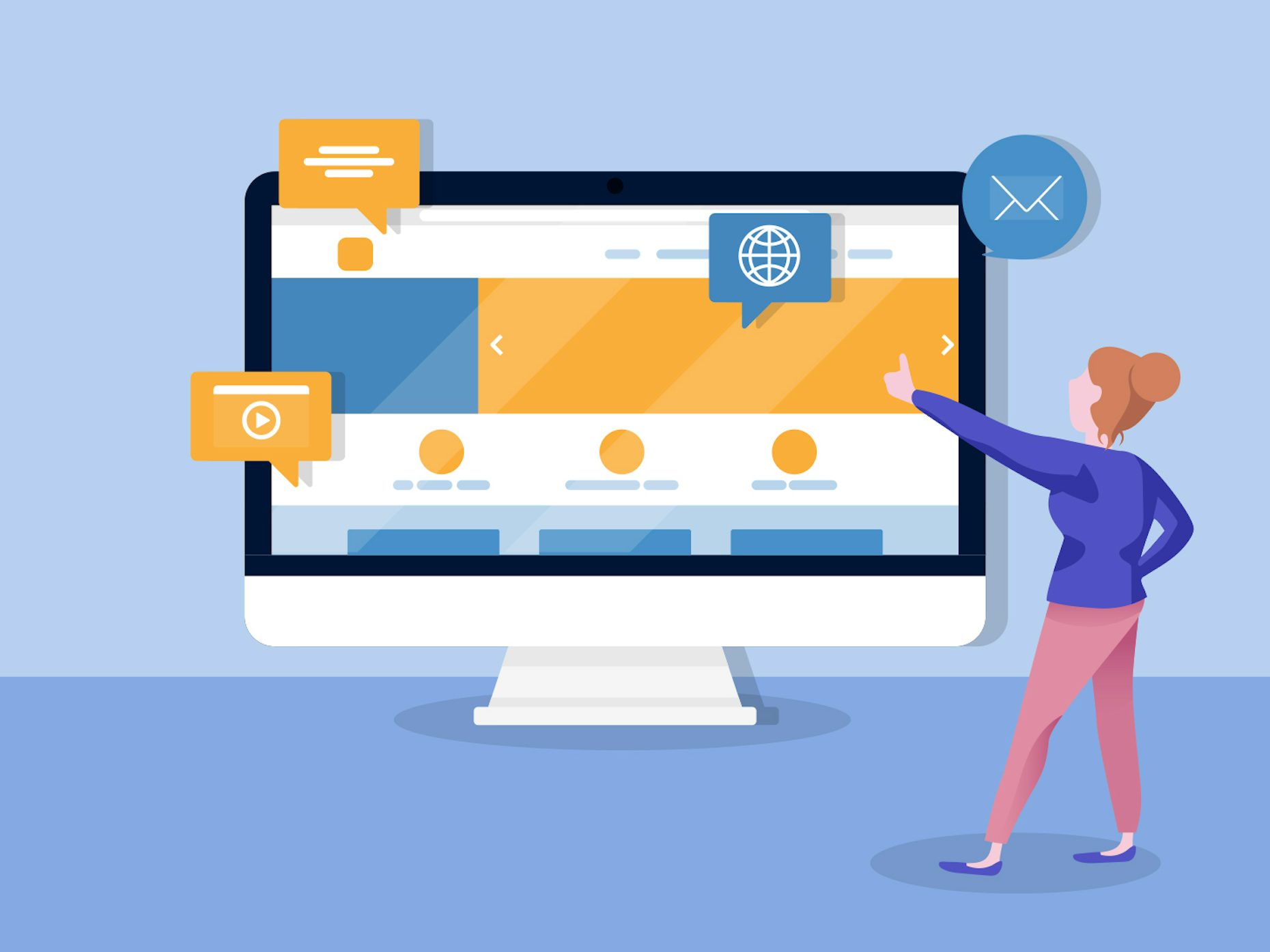All Categories
Featured
Table of Contents
- – Web Design Vs. Web Development - Upwork Tips a...
- – Web Design Services By Freelance Website Desi...
- – Web Development Bachelor's Degree - Full Sail...
- – Mrw Web Design - Wordpress Websites For Nonpr...
- – Learn Responsive Design - Web.dev Tips and Tr...
- – Design Principles - U.s. Web Design System (U...
- – Web Designer News - The Best Curated News Fo...
- – Web Design - Website Design Tutorials, Artic...
- – What Is Web Design? The Ultimate Guide To We...
- – What Is Web Design? - Interaction Design Fou...
- – What Is Web Design? - Interaction Design Fou...
Web Design Vs. Web Development - Upwork Tips and Tricks:
Quick summary Usability and the utility, not the visual style, determine the success or failure of a site. Given that the visitor of the page is the only person who clicks the mouse and for that reason chooses whatever, user-centric design has actually established as a standard technique for effective and profit-oriented website design - web design frederick md.
and the utility, not the visual style, determine the success or failure of a website. Given that the visitor of the page is the only individual who clicks the mouse and for that reason chooses whatever, user-centric style has become a standard technique for successful and profit-oriented web style. If users can't utilize a feature, it may as well not exist.
g. where the search box should be put) as it has already been performed in a variety of short articles; rather we concentrate on the methods which, utilized effectively, can cause more advanced design choices and streamline the procedure of perceiving provided information. Please discover that you may be thinking about the usability-related short articles we have actually published prior to: Concepts Of Excellent Site Style And Effective Website Design Standards, In order to use the principles appropriately we first need to understand how users interact with websites, how they believe and what are the basic patterns of users' habits.
Web Design Services By Freelance Website Designers - Fiverr Tips and Tricks:
Visitors glimpse at each new page, scan a few of the text, and click on the first link that captures their interest or slightly looks like the thing they're trying to find. There are large parts of the page they don't even look at. Many users search for something intriguing (or helpful) and clickable; as quickly as some promising prospects are discovered, users click.
If a page provides users with high-quality material, they want to jeopardize the content with ads and the design of the website. This is the reason why not-that-well-designed websites with high-quality content acquire a lot of traffic over years. Content is more crucial than the style which supports it.

Users don't read, they scan. Notification how "hot" locations abrupt in the middle of sentences. This is common for the scanning process. Extremely basic concept: If a website isn't able to fulfill users' expectations, then designer failed to get his job done effectively and the company loses cash. The higher is the cognitive load and the less intuitive is the navigation, the more ready are users to leave the website and search for options.
Web Development Bachelor's Degree - Full Sail University Tips and Tricks:
Neither do they scan website in a linear style, going sequentially from one website section to another one. Rather users satisfice; they pick the very first sensible alternative. As quickly as they find a link that looks like it might lead to the objective, there is an excellent possibility that it will be immediately clicked.
It doesn't matter to us if we comprehend how things work, as long as we can utilize them. If your audience is going to act like you're designing signboard, then style fantastic billboards." Users wish to be able to manage their browser and count on the constant data presentation throughout the site.
If the navigation and website architecture aren't intuitive, the number of enigma grows and makes it harder for users to comprehend how the system works and how to obtain from point A to point B. A clear structure, moderate visual ideas and quickly recognizable links can assist users to discover their path to their objective.
Mrw Web Design - Wordpress Websites For Nonprofits ... Tips and Tricks:

claims to be "beyond channels, beyond items, beyond distribution". What does it imply? Considering that users tend to explore sites according to the "F"-pattern, these 3 statements would be the very first elements users will see on the page once it is filled. Although the design itself is easy and user-friendly, to comprehend what the page is about the user requires to look for the response.
Once you have actually achieved this, you can communicate why the system works and how users can benefit from it. Individuals won't use your website if they can't discover their method around it. 2. Do Not Misuse Users' Patience, In every job when you are going to provide your visitors some service or tool, attempt to keep your user requirements very little.
Novice visitors want to, not filling long web kinds for an account they may never utilize in the future. Let users check out the site and discover your services without requiring them into sharing personal data. It's not reasonable to require users to enter an email address to test the feature.
Learn Responsive Design - Web.dev Tips and Tricks:
And that's what you desire your users to feel on your web website. The registration can be done in less than 30 seconds as the type has horizontal orientation, the user doesn't even need to scroll the page.
A user registration alone is sufficient of an obstacle to user navigation to cut down on inbound traffic. Manage To Focus Users' Attention, As sites supply both static and dynamic content, some aspects of the user interface bring in attention more than others do.
Focusing users' attention to specific locations of the website with a moderate use of visual components can help your visitors to obtain from point A to point B without thinking of how it actually is supposed to be done. The less enigma visitors have, the they have and the more trust they can establish towards the company the site represents.
Design Principles - U.s. Web Design System (Uswds) Tips and Tricks:
4. Pursue Function Exposure, Modern website design are normally criticized due to their technique of guiding users with aesthetically appealing 1-2-3-done-steps, large buttons with visual results etc. However from the design viewpoint these elements actually aren't a bad thing. On the contrary, such as they lead the visitors through the website material in an extremely simple and user-friendly method.
The site has 9 main navigation alternatives which are noticeable at the first look. What matters is that the material is well-understood and visitors feel comfy with the way they engage with the system.
Rather a cost: just what visitors are looking for. An optimum solution for reliable writing is touse short and succinct phrases (come to the point as quickly as possible), use scannable design (classify the material, use numerous heading levels, use visual components and bulleted lists which break the circulation of uniform text blocks), use plain and objective language (a promo doesn't need to sound like ad; provide your users some affordable and unbiased factor why they need to use your service or stay on your site)6.
Web Designer News - The Best Curated News For Designers Tips and Tricks:
Users are rarely on a site to delight in the style; furthermore, most of the times they are searching for the information despite the style - web design frederick md. Pursue simplicity rather of complexity. From the visitors' point of view, the best website style is a pure text, with no ads or more material obstructs matching exactly the query visitors utilized or the content they have actually been trying to find.
Finch plainly presents the information about the website and provides visitors an option of choices without overcrowding them with unneeded material. Not just does it assist to for the visitors, however it makes it possible to view the information presented on the screen.
Complex structures are more difficult to read, scan, evaluate and work with. If you have the option in between separating 2 style sectors by a noticeable line or by some whitespace, it's normally much better to use the whitespace option. (Simon's Law): the much better you manage to supply users with a sense of visual hierarchy, the easier your content will be to view.
Web Design - Website Design Tutorials, Articles And Free Stuff Tips and Tricks:
The very same conventions and rules should be used to all elements.: do the most with the least amount of hints and visual elements. Clarity: all parts ought to be created so their meaning is not uncertain.
Conventions Are Our Buddies, Traditional style of website components does not lead to a dull website. In truth, as they minimize the learning curve, the need to find out how things work. It would be an use nightmare if all sites had different visual presentation of RSS-feeds. That's not that different from our routine life where we tend to get utilized to basic concepts of how we arrange information (folders) or do shopping (placement of items).
understand what they're expecting from a site navigation, text structure, search positioning etc. A case in point from functionality sessions is to equate the page in Japanese (presuming your web users don't know Japanese, e. g. with Babelfish) and provide your usability testers with a task to find something in the page of various language.
What Is Web Design? The Ultimate Guide To Website Design ... Tips and Tricks:
Steve Krug recommends that it's much better to, however benefit from conventions when you do not. 10. Test Early, Test Frequently, This so-called TETO-principle must be used to every website design project as functionality tests frequently provide into considerable issues and concerns associated with an offered layout. Test not too late, not insufficient and not for the incorrect factors.
Some important indicate keep in mind: according to Steve Krug, and screening one user early in the task is much better than testing 50 near the end. Accoring to Boehm's first law, errors are most regular throughout requirements and style activities and are the more pricey the later on they are removed.
That means that you design something, test it, fix it and then check it once again. There might be problems which have not been found during the very first round as users were virtually blocked by other problems. functionality tests. Either you'll be indicated the issues you have or you'll be indicated the lack of significant style defects which remains in both cases a beneficial insight for your project.
What Is Web Design? - Interaction Design Foundation (Ixdf) Tips and Tricks:

This holds for designers too. After you've worked on a website for couple of weeks, you can't observe it from a fresh perspective any longer. You know how it is constructed and for that reason you understand precisely how it works you have the knowledge independent testers and visitors of your website wouldn't have.
It can be linked to other areas such as graphic style, user experience, and multimedia arts, but is more aptly seen from a technological standpoint. It has actually become a large part of individuals's daily lives. It is difficult to imagine the Web without animated graphics, various designs of typography, background, videos and music.

During 1991 to 1993 the Web was born. Text-only pages might be seen using a basic line-mode browser. In 1993 Marc Andreessen and Eric Bina, created the Mosaic web browser. At the time there were several browsers, nevertheless the bulk of them were Unix-based and naturally text heavy. There had actually been no integrated method to graphic style components such as images or sounds.
What Is Web Design? - Interaction Design Foundation (Ixdf) Tips and Tricks:
The W3C was produced in October 1994 to "lead the World Wide Web to its full capacity by establishing common procedures that promote its evolution and guarantee its interoperability." This discouraged any one company from monopolizing a propriety web browser and programs language, which could have modified the result of the World Wide Web as a whole.
As this has taken place the technology of the web has likewise proceeded. There have likewise been substantial modifications in the way people use and access the web, and this has actually changed how sites are developed. Since the end of the web browsers wars [] brand-new web browsers have been released. A number of these are open source indicating that they tend to have faster development and are more supportive of brand-new requirements.
Learn more about Lovell Media Group LLC or TrainACETable of Contents
- – Web Design Vs. Web Development - Upwork Tips a...
- – Web Design Services By Freelance Website Desi...
- – Web Development Bachelor's Degree - Full Sail...
- – Mrw Web Design - Wordpress Websites For Nonpr...
- – Learn Responsive Design - Web.dev Tips and Tr...
- – Design Principles - U.s. Web Design System (U...
- – Web Designer News - The Best Curated News Fo...
- – Web Design - Website Design Tutorials, Artic...
- – What Is Web Design? The Ultimate Guide To We...
- – What Is Web Design? - Interaction Design Fou...
- – What Is Web Design? - Interaction Design Fou...
Latest Posts
Why Web Design Is Dead - - Ux Magazine Tips and Tricks:
The Top 10 Most Important Elements Of A Website Design Tips and Tricks:
34 Of The Best Website Designs To Inspire You In 2022 Tips and Tricks:
More
Latest Posts
Why Web Design Is Dead - - Ux Magazine Tips and Tricks:
The Top 10 Most Important Elements Of A Website Design Tips and Tricks:
34 Of The Best Website Designs To Inspire You In 2022 Tips and Tricks: